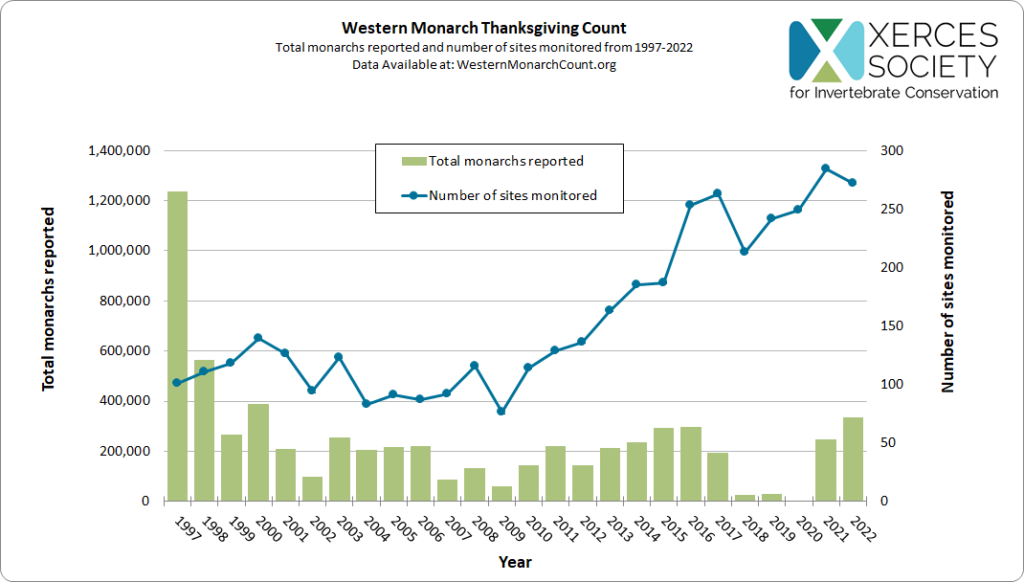The western monarch population continued its growth in 2022, according to overwintering count totals recently released by the Xerces Society. The 2022 Western Monarch Thanksgiving Count tallied 335,479 monarchs, an increase from the remarkable rebound from the previous year, which came in at nearly 250,000.

The annual Western Monarch Thanksgiving Count surveyed 272 overwintering sites. According to the Xerces Society, two Santa Barbera sites reported the most monarchs with a site owned by The Nature Conservancy tallying 34,180 while a private residential site in the county recorded 25,710 monarchs. Pismo State Beach Monarch Butterfly Grove had the third largest monarch count with 24,128 butterflies.
“We can all celebrate this tally,” said Emma Pelton, a conservation biologist at the Xerces Society and western monarch lead, in a blog post accompanying the announcement of the western monarch population numbers. “A second year in a row of relatively good numbers gives us hope that there is still time to act to save the western migration. That said, we know we still have a long way to go to reach population recovery and the storms that hit right afterwards mean we’ll start the spring with far, far less than this total.”
The Xerces Society also highlighted in its announcement the potential impact the winter storms in California had on monarch overwintering grounds. According to Xerces, the storms caused butterflies to be blown out of their clusters at some overwintering sites, making them more vulnerable to cold, wet conditions and predation. Populations at other overwintering sites fared better but, as Pelton referenced, it is likely the storms will impact this spring’s breeding population.
Western monarchs breed west of the Rocky Mountains and overwinter primarily along the Pacific Coast. The much larger eastern population overwinters in the oyamel fir forests of central Mexico, with those tallies expected to be available in the coming weeks. The eastern and western populations each face unique conservation challenges, so we must continue to address the needs of both to ensure they recover to sustainable population levels.
While the continued rebound is encouraging, conservation and pollinator habitat establishment efforts must continue to be strengthened to sustain monarch populations. Farmers for Monarchs aims to identify agricultural and conservation practices that support healthy monarch populations and increase awareness of those practices among all stakeholders. Just as the eastern monarch population relies heavily upon the agricultural Midwest as a productive breeding area, the western population relies heavily upon early spring breeding in the agricultural Central Valley of California. It takes a concerted effort from all sectors, including the agriculture community, to plant, enhance, and protect forage to revive pollinator populations. Below is a list of government and non-government organizations, programs, and resources offered to help California farmers and ranchers establish pollinator habitat:
- The U.S. Department of Agriculture
- Practice 327A, Conservation Cover, Pollinators
- Practice 422A, Hedgerow Planting, Pollinators
- The Environmental Quality Incentive Program (EQIP)
- The Agricultural Conservation Easement Program (ACEP)
- The Conservation Stewardship Program (CSP)
- The Conservation Reserve Program (CRP)
- The U.S. Fish and Wildlife Service
- California Department of Food and Agriculture
- California Association of Resource Conservation Districts
- Monarch Joint Venture
- Project Apis m. Seeds for Bees cover crop program
- Bee and Butterfly Habitat Fund
- Environmental Defense Fund
- Pollinator Partnership
You can get more information on these and other resources by visiting the State Planting Resources page on our website. You can also contact the Monarch Joint Venture’s Pollinator Habitat Help Desk at (337) 422-4828 or (337) HABITAT for more information on planting milkweed and other pollinator habitat on your land.
